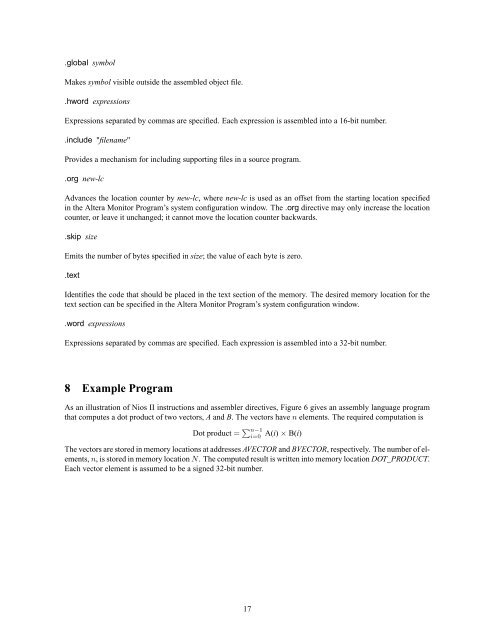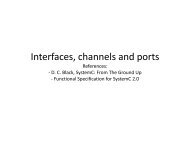Introduction to the Altera Nios II Soft Processor - FTP - Altera
Introduction to the Altera Nios II Soft Processor - FTP - Altera
Introduction to the Altera Nios II Soft Processor - FTP - Altera
Create successful ePaper yourself
Turn your PDF publications into a flip-book with our unique Google optimized e-Paper software.
.global symbol<br />
Makes symbol visible outside <strong>the</strong> assembled object file.<br />
.hword expressions<br />
Expressions separated by commas are specified. Each expression is assembled in<strong>to</strong> a 16-bit number.<br />
.include "filename"<br />
Provides a mechanism for including supporting files in a source program.<br />
.org new-lc<br />
Advances <strong>the</strong> location counter by new-lc, where new-lc is used as an offset from <strong>the</strong> starting location specified<br />
in <strong>the</strong> <strong>Altera</strong> Moni<strong>to</strong>r Program’s system configuration window. The .org directive may only increase <strong>the</strong> location<br />
counter, or leave it unchanged; it cannot move <strong>the</strong> location counter backwards.<br />
.skip size<br />
Emits <strong>the</strong> number of bytes specified in size; <strong>the</strong> value of each byte is zero.<br />
.text<br />
Identifies <strong>the</strong> code that should be placed in <strong>the</strong> text section of <strong>the</strong> memory. The desired memory location for <strong>the</strong><br />
text section can be specified in <strong>the</strong> <strong>Altera</strong> Moni<strong>to</strong>r Program’s system configuration window.<br />
.word expressions<br />
Expressions separated by commas are specified. Each expression is assembled in<strong>to</strong> a 32-bit number.<br />
8 Example Program<br />
As an illustration of <strong>Nios</strong> <strong>II</strong> instructions and assembler directives, Figure 6 gives an assembly language program<br />
that computes a dot product of two vec<strong>to</strong>rs, A and B. The vec<strong>to</strong>rs have n elements. The required computation is<br />
Dot product = ∑ n−1<br />
i=0<br />
A(i) × B(i)<br />
The vec<strong>to</strong>rs are s<strong>to</strong>red in memory locations at addresses AVECTOR and BVECTOR, respectively. The number of elements,<br />
n, is s<strong>to</strong>red in memory location N. The computed result is written in<strong>to</strong> memory location DOT_PRODUCT.<br />
Each vec<strong>to</strong>r element is assumed <strong>to</strong> be a signed 32-bit number.<br />
17

















